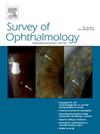降低锁膜外静脉压在青光眼治疗中的临床意义及Rho激酶抑制剂的应用。
IF 5.9
2区 医学
Q1 OPHTHALMOLOGY
引用次数: 0
摘要
在临床实践中,测量和调节外膜静脉压(EVP)的成功率有限。了解EVP在不同患者青光眼治疗中的潜在作用,可以使治疗方法更加个性化。为了探讨降低EVP的临床意义,一个由9名青光眼专家组成的国际小组(ENGAGE全球专家工作组)召开会议,以弥合目前文献和临床意见和最佳实践证据之间的差距。这篇综述总结了该小组对当前药物治疗对EVP的影响及其潜在影响的见解。它还讨论了未满足的研究需求,以加强对EVP的理解,以及与EVP的测量和治疗相关的挑战。尽管目前的治疗方法能相对适度地降低EVP,但EVP降低对青光眼患者,特别是低眼压患者可能具有临床意义。可能受益的人群包括EVP升高的患者;正常眼压青光眼;接受小梁网搭桥手术、骨切开术或选择性激光小梁成形术;或需要将IOP进一步降低到十几岁或低于正常目标IOP。本文章由计算机程序翻译,如有差异,请以英文原文为准。
Clinical implications of lowering episcleral venous pressure in the management of glaucoma and the use of Rho kinase inhibitors
There has been limited success in both measuring and modifying episcleral venous pressure (EVP) in clinical practice. Understanding the potential role of EVP in the management of glaucoma for different patients may allow for more individualized treatment approaches. To explore the clinical implications of lowering EVP, an international group of 9 glaucoma experts (the ENGAGE Global Expert Working Group) convened to bridge the gap between the current literature and evidence with clinical opinion and best practices. This review summarizes insights from the group on the effect of current medical therapies on EVP and its potential impact. It also discusses unmet investigational needs to enhance the understanding of EVP, as well as the challenges associated with the measurement and treatment of EVP. Regardless of the relatively modest EVP reductions achieved with current treatments, EVP lowering may have clinical significance in patients with glaucoma, particularly those with low intraocular pressure (IOP). Those who might benefit include patients with elevated EVP; normal-tension glaucoma; undergoing trabecular meshwork bypass surgery, goniotomy, or selective laser trabeculoplasty; or requiring additional IOP lowering to the low teens or with a lower-than-usual target IOP.
求助全文
通过发布文献求助,成功后即可免费获取论文全文。
去求助
来源期刊

Survey of ophthalmology
医学-眼科学
CiteScore
10.30
自引率
2.00%
发文量
138
审稿时长
14.8 weeks
期刊介绍:
Survey of Ophthalmology is a clinically oriented review journal designed to keep ophthalmologists up to date. Comprehensive major review articles, written by experts and stringently refereed, integrate the literature on subjects selected for their clinical importance. Survey also includes feature articles, section reviews, book reviews, and abstracts.
 求助内容:
求助内容: 应助结果提醒方式:
应助结果提醒方式:


